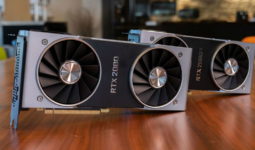The Best 4K TVs of 2018

If you’re shopping for a TV for your living room these days, most of what you’ll see are 4K Ultra HD TVs — and with good reason. Frankly, we don’t think you should buy a midsize screen or bigger that doesn’t support 4K, especially if you don’t want to have to buy a new TV in the next few years. Yes, they’re really that good, especially when you factor in other picture quality improvements like high dynamic range (HDR).
If you’re on a budget, we’ve got lists of the best TVs you can buy for under $1,000 and even under $500 — and you’ll find 4K TVs on those lists, too. Still, if you want to make your shopping simple and you’re just looking for some of the best 4K TVs available today, read on for a few of our current favorites.
Not sure what size TV you need, we’ve got a handy guide to help you out.
At a glance
LG C8-Series 4K OLED TV
The best

Why you should buy this: It boasts great picture quality at a price lower than many other OLEDs.
The LG C8 offers everything you could want in an OLED TV with impressive contrast, great black levels, and just the right features.
Who it’s for: Everyone who can afford it.
How much it will cost: $2,500 to $3,500
Why we picked the LG C8-Series 4K OLED TV:
It doesn’t matter which model in LG’s current line of OLED TVs you pick if all you’re looking at is picture quality, as the panel used is the same across all of them. What you need to focus on with regard to different models is the size of said panel, as well as the feature set packed into it, and the C8 series happens to sit at the ideal intersection of size, features, and cost.
Most people won’t want to opt for the $9,000 77-inch model, but at $3,500 and $2,500 respectively, the 65-inch and 55-inch models each offer a fantastic deal when you consider what you’re getting. Not only do you get a 4K Ultra HD display with every major type of HDR — HDR10, Dolby Vision, and Hybrid Log Gamma — but the TV is also powered by LG’s solid webOS smart TV interface. There are bigger, fancier TVs, but even those with a taste for the highest of the high-end will find themselves impressed by this series.
Read our full LG C8-Series 4K OLED TV review
Sony Master Series A9F OLED TV
The best ultra-premium OLED TV
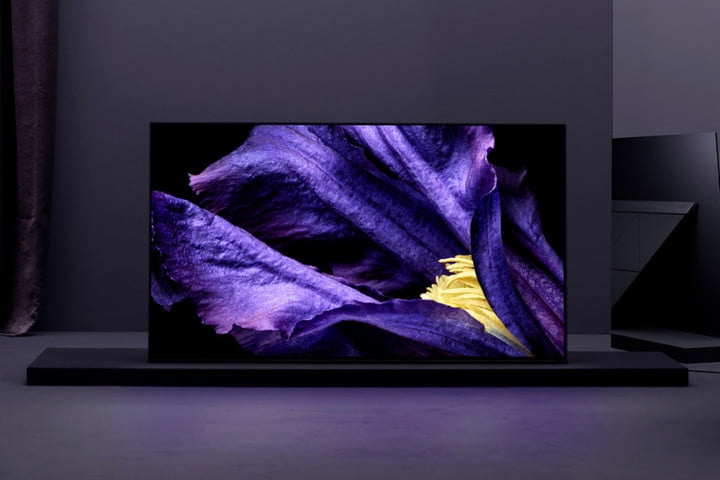
Why you should buy this: It’s the most impressive picture quality we’ve seen, full stop.
Who it’s for: Anyone looking for the absolute best OLED TV experience money can buy.
How much it will cost: TBA
Why we picked the Sony Master Series A9F OLED TV:
In a head-to-head comparison with LG OLEDs, Sony’s OLED TVs have managed an edge because of one thing: processing. Sony’s processing has always been top-notch, and with the X1 Ultimate processor found in this TV, the company has outdone itself. When we saw this TV in person, we couldn’t help but notice how much the HDR highlights stood out — much more so than on past Sony TVs. Then there is the sound, which comes from the screen itself.
Using a bit of acoustical trickery that it calls Acoustic Surface Technology, Sony puts actuators on the back of the screen itself to provide sound, making the TV incredibly thin. Thanks to a new third actuator and a second woofer mounted on the back of the television, the sound is surprisingly good, and the TV can even function as the center channel for your home theater speaker setup. This is a TV that needs to be experienced in person in order to see just how capable it is.
No pricing information is available for this TV just yet (coming this fall) but it’s a good bet it will be a bit pricier than the A8F OLED positioned below it.
Sony Master Series Z9F TV
The best ultra-premium LED/LCD TV
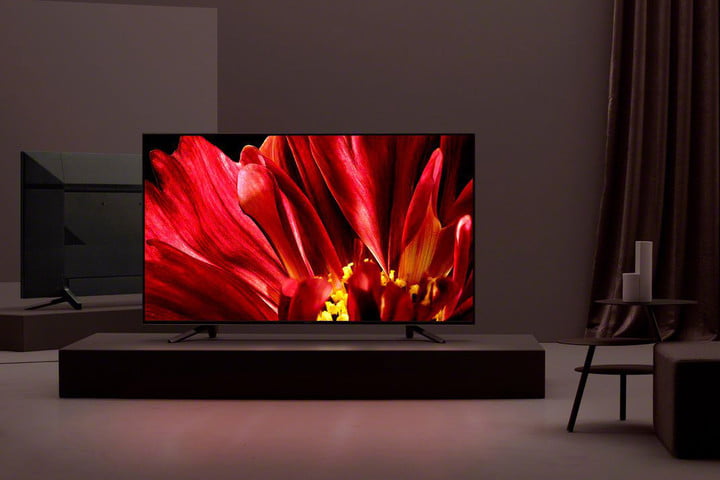
Why you should buy this: It’s the best-looking LED/LCD we’ve ever seen.
Who it’s for: Anyone looking for a sleek TV without the pitfalls associated with most LED/LCD TVs.
How much it will cost: TBA
Why we picked the Sony Master Series Z9F TV:
If you think that OLED is the way of the future, you very well could be right, but if you think it’s the only way to get a fantastic-looking TV, you might want to take a look at Sony’s Master Series Z9F first. A direct challenger to Samsung’s QLED series, the Z9F aims to replicate everything OLEDs are known for, from deep blacks to wide viewing angles. Using the same X1 Ultimate processor as its A9F OLED, this TV adds something Sony calls X-Wide Angle technology to combat the off-angle washout that plagues many LCD TVs. In our time testing the Z9F, colors looked almost as vivid from extreme angles as they did from directly in front.
No word yet on pricing for this TV (coming this fall), but this TV’s predecessor came out two years ago at $7,000 for the 65-inch and $10,000 for the 75-inch model. Given the upgrades, we may see similar pricing, but we’ll hold out hope that they may come down a bit given the couple years that have passed.
Samsung Q9FN 4K QLED TV
The best overall LED/LCD TV
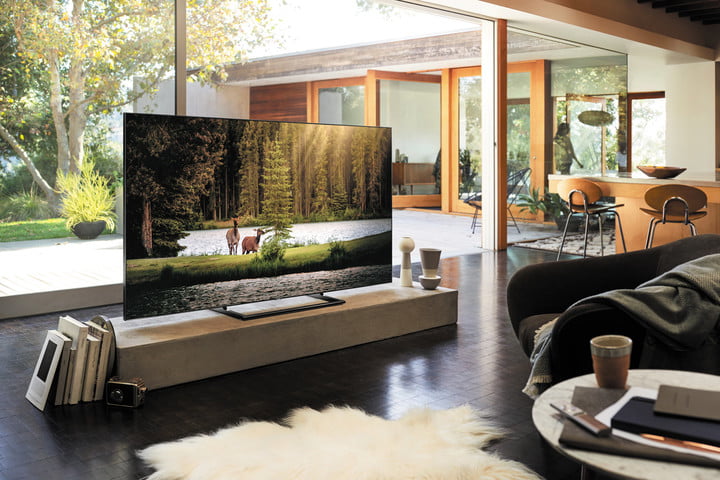
Why you should buy this: It combines a great-looking picture with handy features.
Who it’s for: Anyone looking for a fantastic display that will seamlessly blend into their home.
How much it will cost: $3,800 to $6,000
Why we picked the Samsung Q9FN 4K QLED TV:
If Sony’s Z9F isn’t proof enough for you that LED/LCD TVs still have plenty to offer, take a look at Samsung’s Q9FN QLED TV. While we may prefer the display of the Z9F, the Q9FN’s picture is plenty amazing, and this TV backs it up with a boatload of features. The Ambient mode lets the TV blend into your living room like a chameleon when you’re not watching it, and while bundling power into the One Invisible Connection cable between the One Connect box and the TV makes the cable slightly thicker, it also means you truly only have one cable (barely) showing on your wall.
We also love the Tizen smart TV interface, which we find easier to use than Android TV. If you don’t want your TV to dominate your living room all the time but want all the goodness of a big screen when you are watching TV, the Q9FN is a perfect choice.
Read our full Samsung Q9FN 4K QLED TV review
TCL 6-Series Roku TV
The best high-performance budget TV
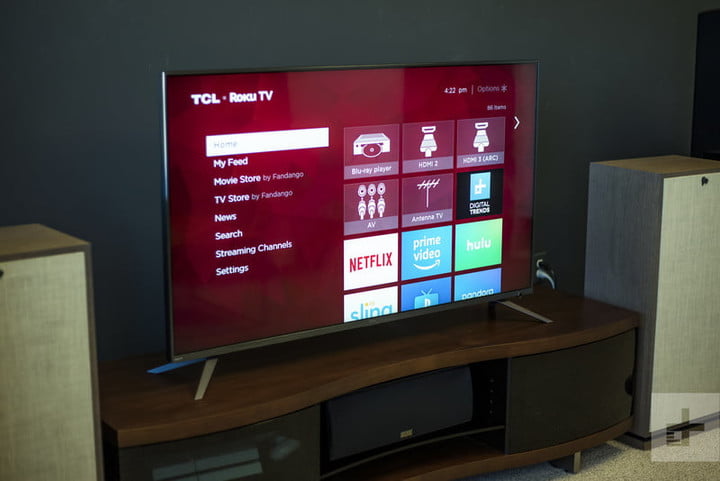
Why you should buy this: It has one of the best price-to-performance ratios we’ve ever seen.
Who it’s for: Those who want to save a buck but don’t want to skimp on quality.
How much it will cost: $650 to $1,000
Why we picked the TCL 6-Series Roku TV:
Even before the TCL 6-Series Roku TVs were on sale, we could tell they’d be one of the biggest TVs of the year — in terms of popularity, that is — after seeing them in person at CES 2018. You’ll find the 55-inch inch model at the incredible price of around $650, with the more expensive 65-inch model at $1,000 still dramatically cheaper than any other TV that size with the same features.
In addition to every current HDR technology, the 120 local dimming zones in the 65-inch model and 96 in the 55-inch model combine with TCL’s HDR Pro Gamma technology to match your room’s brightness and provide an excellent picture no matter what your room lighting is like. Add the integrated Roku smart TV features to the equation and you’ve got a TV that is as comfortable in a bedroom as it is in your living room.
How we test
We begin each model year by bringing in the top-tier televisions from each of the major brands, including Samsung, Sony, LG, and others. These premium televisions help set the highest standard for the year, managing expectations for each model below them, and providing context among the competitors.
We begin testing by setting up each TV in a completely dark room and adjusting its picture settings using tools and methods readily available to consumers — just like you might do at home. From there, we use a series of test patterns and familiar content, from streaming services to Ultra HD Blu-ray to over-the-air (OTA) TV, to judge each TV’s performance characteristics, including color production, motion resolution, black levels, backlight influence, brightness, HDR quality, and detail resolution.
Once we’ve analyzed a TV’s picture quality, we move on to elements that affect the user experience, including each set’s smart TV interface, user settings interface, remote control, external device recognition and control, and other essential touchpoints.
When possible, we’ll place two competing models side by side to provide additional context for the pros and cons each TV exhibits. Finally, we make a determination as to which type of user a TV might appeal to. For instance, some TVs provide better bright-room performance, while others are better for dedicated home theater performance. Some are better for sports, while others are better for watching movies or playing games.
In short, we make a thorough evaluation to determine not only which TVs offer the best picture quality, but those that offer the best overall user experience. After all, you’ll be living with your new TV for years to come, and using it should be a joy, not a pain.
Read our complete test methodology for more information.
Helpful tips
When shopping for a new TV, it pays to do some research, but keep in mind that specs are often loaded with misinformation. Trust reviews from multiple review sites (including Digital Trends, of course), then go see the TV in action at a local retailer.
If you can, try to get a hold of the TVs remote control and play around with it a bit. Ask an associate to take the TV out of store demo mode so you can look at some of the set’s built-in picture presets if possible. Moreover, try to determine if the TV’s user menu and smart TV interface are easy to navigate and intuitive.
Finally, make sure the retailer you are going to purchase from is an authorized retailer for the brand, and ensure they offer a fair and hassle-free return process. Most authorized online retailers are very accommodating when it comes to returns or replacements.
Glossary of terms
Here’s a rundown of some of the most common terms associated with today’s TV technology.
4K Ultra HD
This refers to a display resolution that is four times that of 1080p HD. A 4K Ultra HD TV’s pixel resolution is a 3,840 x 2,160 grid in a 16:9 aspect ratio, resulting in nearly 8.3 million pixels. This increase in density adds striking detail and realism to an image and allows larger screens to be viewed from closer distances without individual pixels becoming visible.
High Dynamic Range (HDR)
High dynamic range is probably most familiar to people through the HDR mode on their digital cameras. It’s designed to deliver a picture that has greater details in the shadows and highlights, plus a wider range of colors. HDR in televisions pursues the same goal. The color palette is wider, blacks are deeper, and whites are brighter. Presently, there are two major HDR formats: HDR10 and Dolby Vision. The former is the HDR standard, but Dolby Vision offers a premium experience. Consider a TV that supports both. HLG (Hybrid Log Gamma) is another recent addition to the HDR collection, which supports over-the-air (OTA) broadcast content with HDR.
Full Array Local Dimming (FALD)
This refers to an LED TV’s backlighting system. A FALD display contains an array of LEDs spread out in a grid behind an LCD panel, rather than just at the edges of the TV. This LED array is broken up into zones that can be dimmed when necessary to achieve better black levels. Another benefit is more uniform brightness across the screen.
Wide Color Gamut (WCG)
These are the expanded color reproduction abilities of a 4K Ultra HD TV, which are closer than ever to what we see in a digital cinema. By approaching the Digital Cinema Initiative’s P3 color specification, a 4K UHD TV can produce billions more colors than a 1080p HD TV.
Quantum dots
A layer of film loaded with tiny nano-crystal semiconductors that is placed in a TV’s display panel to help produce a wider array of colors. Quantum dots work by altering the light coming from a TV’s backlighting system before it is passed through the TV’s color filter.
Phosphor-coated LED
An alternative to Quantum Dots, phosphor-coated LEDs have a chemical coating to alter the light’s output. When used in a TV, this results in a purer backlight that’s more easily manipulated by a TV’s color filter, resulting in a wide color gamut and increased color accuracy.
OLED
This stands for Organic Light-Emitting Diode. These are much smaller than standard LEDs, letting them function as the individual pixels of a display. For more information, see our OLED versus LED article.
HDMI 2.0a
The latest version of the HDMI spec. Compliance with this standard assures a 4K Ultra HD display or source is capable of providing all the digital information needed for 4K Ultra HD resolution, HDR, and Wide Color Gamut, all at up to 60 frames per second.
HDCP 2.2
The latest version of the High-Bandwidth Digital Content Protection technology, which provides copy prevention specifically of 4K Ultra HD content. Any source device that requires HDCP 2.2 will require a 4K Ultra HD TV with an HDCP 2.2-compliant HDMI port for a compatible connection.
HEVC (H.265)
Stands for “High-Efficiency Video Coding.” A new compression technology developed to make large 4K UHD video files smaller and, therefore, easier to stream over broadband Internet connections. HEVC is said to double the data compression ratio over H.264, the predominant encoding technology used today for 1080p videos while retaining the same video quality. A smart TV or streaming set-top box must be able to decode HEVC in order to play back 4K Ultra HD video from sites like Netflix and Amazon Instant Video.
VP9
An alternate to HEVC developed by Google and used predominantly for encoding 4K Ultra HD YouTube videos. In order for a smart TV or streaming set-top box to play back 4K Ultra HD YouTube videos, it must be able to decode VP9 videos.



